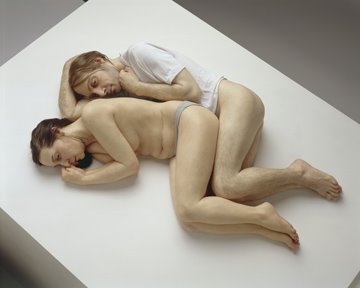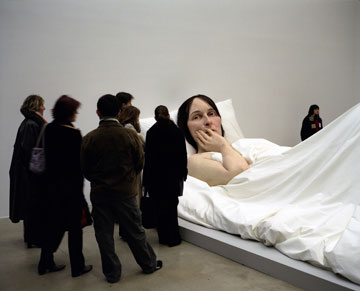 'In Bed' detail
'In Bed' detailRon Mueck (pronounced Mewick), 48, was born in Australia. His parents, of German descent, were toy makers who emigrated to Britain when Mueck was small. He is self-taught as an artist, and honed his skills making models for film, television and advertising. At one stage he worked for the master puppeteer Jim Henson of The Muppet Show, and created special effects for such films as Labyrinth, starring David Bowie. He set up his own production company in London, making models for the advertising industry, and began to experiment with fibreglass resin; he had found his bronze and stone. He began to do pieces for himself that included photography, but soon became disillusioned with the camera as he believes a photograph 'destroys the presence of the object'.
The studio is a workshop packed with tools and equipment, some of which Mueck has invented for his own ends. Scattered on the floor were anatomical text books, photography, hair pieces and bits and bobs of semblances of human anatomy. The pinboard displayed shots of babies' faces, mythological creatures, grotesque faces, cartoon-like figures, and close-ups of eyeballs. Susanna Greeves, a former director of the Anthony d'Offay Gallery, who has worked with the artist for many years, says that Mueck 'lavishes extraordinary care on hand-making his model's eyes in many stages, building up a transparent lens over a coloured iris and deep black pupil. When he finally inserts them, the effect is startling.'
 'Spooning Couple'
'Spooning Couple' 'Spooning Couple' detail
'Spooning Couple' detail
Advances in technology have enhanced his technique, but much of his actual process has been used by sculptors down the ages. He makes plaster maquettes to test ideas, does drawings of various sizes and takes decisions on the scale of the piece. He then sculpts the figure in clay with all the lifelike touches that will appear in the final sculpture. A mould is made of the clay figure and he casts it out in fibreglass resin and silicone. The skin of his figures, which tempts people to peer at it to see if it could be real, is built up from layers of silicone. The lower layers are impregnated with pigment, resulting in a finish that has the slight transparency of the real thing. Each hair is sewn by hand. Greeves says, 'The slightest trace of a seam or any other technical blemish would ruin the illusion and the piece would lose its power.'
Link to Telegraph article.



No comments:
Post a Comment